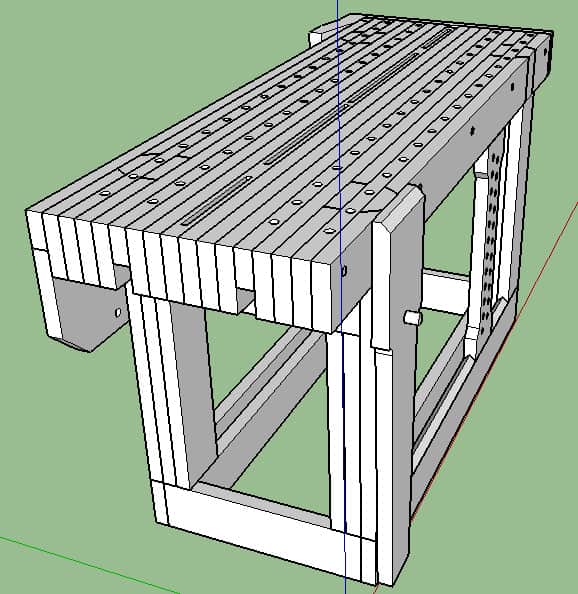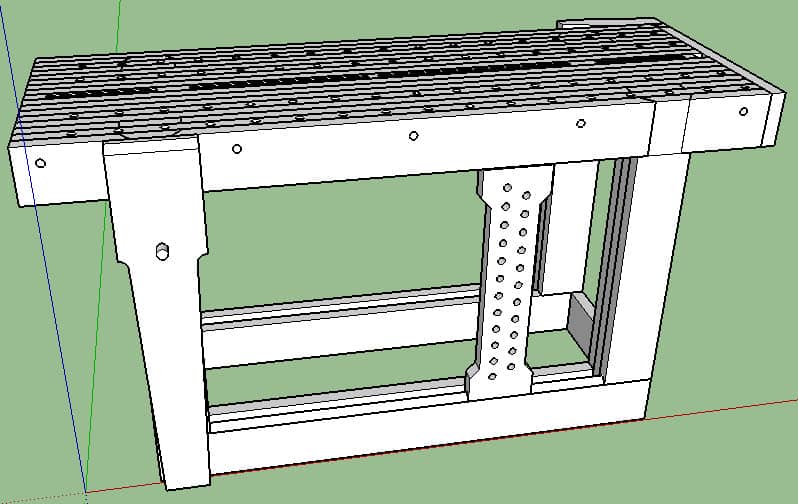This post contains affiliate links.
When we first moved to the Ohio Valley, I started setting up my shop and built a workbench and somewhere to store tools. It’s still there and it works just fine, but it’s not really ideal for the woodworking projects I have coming up. I think it will be great for mechanic-type work. I’ll move it to the other side of the pole barn and build another one.
What I Need It to Do
My new workbench needs to be a bit shorter than my old one. I’m planning for a 38-inch bench height. Paul Sellers, the best hand-tool guy I can find on YouTube, says 38 inches is just fine for the average-height person. Since I’m of average height, I’ll trust him.

It needs to be heavy so it doesn’t move unless I really want it to. A laminated top and stout legs will provide the stability and heft that I need. With the floor in the shop being epoxy painted, it’s a little slick. I’ll probably have to put some rubber on the bottom of the legs to help it not slide.
Since it will be used mostly for assembly and hand-tool work, it needs good work-securing options. Probably holdfasts, dogs, and both a leg vise and end vise.
The Design
I really like James Hamilton’s design for a Roubo-style bench. I’ve read a bunch of things about both Roubo benches and Nicholson (English) benches, and since I don’t really know what I want or need, I thought I’d make a variation on this “perfect” workbench.
The top will be six feet long, made from laminated-together 2×6 stock. I’m going to make it a bit of a split-top Roubo style with a 1-1/2 inch gap between the top halves. That’s very intentional, which I’ll get into later. A row of dog holes and a row of hold-fast holes on each top half will give me work-holding options, both 3/4-inch so parts can be somewhat interchangeable for work holding.
One side (and end) will have Roubo-style fixtures – leg vise, end (tail) vise, and a sliding deadman. The other side will have a Nicholson-style apron so I can use the holdfasts to hold work pieces to work on the edges. I’ll leave an inch-and-a-half gap between the two halves of the top that will house a combination vertical tool holder and stop for planing/working on smaller pieces.

Legs will be attached to the top with the double-mortise design from the Stumpy Nubs bench. The top layers will be laminated together using double-wedged dowels instead of threaded rod, though. I want to use as few metal fasteners as possible, to see if I can.
Materials
I’ll use ordinary construction-grade wood for all the major parts of the top and base. If I get 12-foot 2×12’s, I can cut at least 4 parts out of each, especially the bench top layers. If I rip them down the center and cross-cut in half (not necessarily in that order) will yield 4 layers of the benchtop for each 2×12. I’ll need a 2×8 to make the leg vise out of, as well as 6 dowels to cut down for joining the layers of the benchtop.
I haven’t quite settled on the design for the end vise and leg vise. I think I want to make the leg vise from a scaffold leveling screw. Maybe I can make the end vise from two pipe clamps like Jay Bates used for making Moxon vises.